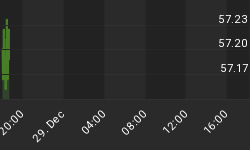The Gold Bull Market
Towards the end of last year the Fed confirmed that it would increase the supply of dollars by whatever extent was necessary to cause prices to rise. At the time that Fed representatives Greenspan and Bernanke made this promise the US$ had already been trending lower and the US$ gold price trending higher for 2 years, but having the Fed spell-out its intention to devalue the dollar should have been a wake-up call to the markets. In particular, it should have been a wake-up call to those who perceive deflation to be a clear and present danger. Those who expect deflation to occur in the US over the next 2 years must think Greenspan and Bernanke were lying when they promised to do whatever it took to de-value the dollar or they must not understand the power the Fed possesses in the field of currency creation.
If the Fed stuck to its traditional modus operandi and simply adjusted bank reserves in order to maintain a short-term interest rate (the Fed Funds Rate) at some arbitrary target level, then under certain conditions Greenspan and Co. would not be able to facilitate an increase in the supply of money. This is because they would necessarily be relying on individuals and corporations borrowing more money into existence in response to the lower short-term rates. But, if people were already 'tapped out' or returns on investment were very low then even a zero percent interest rate might not prompt significant new borrowing. The Fed's power is not, however, limited to the targeting of short-term interest rates. In order to increase the supply of money the Fed could, if it chose to do so, purchase private assets such as stocks, corporate bonds and real estate using newly-printed dollars. So, the question isn't whether the Fed has the power to inflate, the question is whether it will choose to inflate and by how much. Fortunately we don't need to guess the answer to this question because the Fed has already given us the answer. We can therefore be very confident that the price of gold is going much higher over the next few years and just concern ourselves with the path it is going to take to get from where it is now to that much higher price.
The Dollar - current market situation
Below is a chart of the Dollar Index showing the 'hill' (the trend-line) that it has been bouncing down over the past 2 years.

After the Dollar hit the trend-line shown on the above chart in early-February we said that the decline did not appear to be complete and that another test of the trend-line would likely happen in the near future. That test has just occurred, so from this perspective the Dollar is very close to an intermediate-term bottom.
From an Elliott Wave perspective an important bottom also appears to be close at hand. It looks like the Dollar is in the 5th (final) wave of the decline that began in July of 2001. This 5th wave has, in turn, evolved in a clear 5-wave pattern with the Dollar now being in the final wave (labeled as (v) on the above chart).
Further to the above, the current phase of the Dollar's bear market (the phase that began in July of 2001) is probably almost over and a multi-month correction should soon begin. However, we are confident that the Dollar will trade significantly lower before this year is over (we expect that the October-1998 low (around 92) will be tested this year). Also, the fact that the US current account deficit has not yet begun to improve indicates that the Dollar index will trade well below 90 during 2004 (based on historical precedent, the Dollar's exchange value will keep trending lower until the US is running a quarterly current account surplus).
Note that although the Dollar is probably close to a low it is yet to provide any technical confirmation that a low is in place. As is the case with the stock market we expect that a low will be in place before the end of this month, but a final downward spike (to around the 95 level) is possible over the coming 2-3 weeks.
















